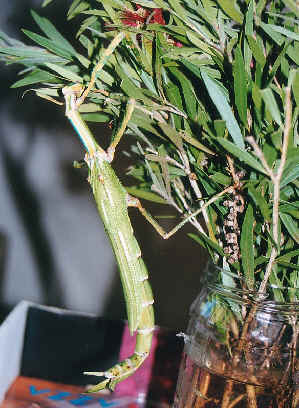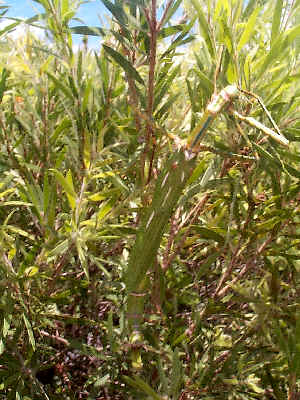Goliath Stick Insect, the Camouflage Master - Eurycnemma goliath
This page contains pictures and information about the Goliath Stick Insects that we found in the Brisbane area, Queensland, Australia.

- Adult female, body length 210mm
Goliath Stick Insect
- The Goliath Stick Insects are very large insects. They are the second largest stick insect in Australia. The largest insect in Australia is also a stick insects known as Titan Acrophylla titan, which is 250mm long but thinner than Goliath. Goliath Stick Insects are common in Brisbane. However, they are not easily seen because of their excellent camouflage and they usually hide in the tree top. We found this Goliath Stick Insect on a shrub near a shopping mall in Wishart, in mid summer on a Red Bottle Brush Plant. This is quite unusual for they normally feed on the top of eucalypts. It could have been blown down by the wind for we just had a storm a few days ago. We decided to bring it home for a few days to study.


- Goliath Stick Insects' bodies colour and shape made them look like part of the plant. The second picture is taken when we first saw the Goliath.
Goliath Female
- Goliath Stick Insects are green in colour. The females have a fat abdomen, with white rings around. Their forewings are smaller which cover only a small part of their hind wings, while the hind wings cover part of their abdomen. Its wings are also green in colour with some white markings on each wing. Their thorax are long and yellow in colour, with green-blue stripes running along the thorax.
- After we took the Goliath back home, it started to lay eggs the next day. It could be the reason why it went onto a low shrub. In the first two days it laid one egg about every hour. It laid fewer eggs the following days. It laid eggs for about two weeks and in total there are 132 eggs. It just drops its eggs onto the ground. The eggs look like seeds, approximately 6mm in length and brown in colour. The eggs have a stopper like cap at one end, called a capitulum. We decided to keep a few eggs and see how they hatched. For the others, we will put them back with the Goliath to the shrub where we found it. Please come back to visit this page later for the results of the eggs hatching. (See below)

- The eggs of the Goliath Stick Insect look like seeds, notice that they have a stopper like cap at one end, called a capitulum.
Goliath Eggs
Goliath Male
In a morning of early summer 2001, we found a male Goliath Stick Insect outside our windows. He could be attached to there by the window light. A male Goliath comes to visit us is not common in Brisbane. We kept it for study for a few days. For the female, she quite happy to stay on the plant that we provided, have no intention to escape. However, the male will not stay at the same place overnight. Everyday in the morning, it will not be seen on the plant. We have to search in our home to look for it.
The male Goliath is the same colour as the female, with shorter body and slender abdomen. However, its antennae are much longer, 60mm, twice the length of the female.
Master of Camouflage
- Goliath Stick Insects are the master of camouflage. We notice that they have at least the following methods to hide themselves from predators;

- 1. Their bodies, colour and shape made them look like part of the plant.
- 2. When staying motionless, they always put their front legs in front of their head, to made themselves look more like part of the plant.
- 3. They usually feed at night, during the day time they just hang motionless on the plants.
- 4. They eat the whole leaf, usually they do not leave part of the leaf uneaten, like most grasshoppers do.
- 5. Even when they move, they simulate the swaying motion, like the movement caused by the wind blowing.
- 6. Their eggs, called ova, look like seeds, so the predators do not notice the insect by the seeds.
- 7. They discard their dropping, called frass, very far away so that the predators do not notice the insect.
They Don't 'Drop' Droppings
- Goliath Stick Insects eat a lot of plants materials and they leave a lot of droppings. To avoid the predators notice them by their droppings, the insect has a very special way to handle it. At the rear end of the insects' abdomen, they have three large filaments. The middle filament holds the dropping when it comes out. The stick insects will flip their abdomen to throw their droppings a few meters away. This habit has another advantage. The stick insects lays their eggs and let them free falling onto the ground. Discarding their droppings far away so that the eggs will not be mixed with their droppings.


Active Defence
- By watching the Goliath, we notice that it has at least the following defence mechanisms. Of course its primary mechanism is its heavy camouflage. Its appearances and its movement resembles twigs or branches so that it can hide away from predators. It's second defence mechanism is to scare its predators. When disturbed it will display the bright red colour under its wings and the eyes-patterns between the thorax and rear legs. Together with a swishing sound apparently coming from the wings. It will also kick its spiny legs which will help frighten the predator. We also noticed that the Goliath we found, one of its rear leg is missing, the other rear leg is a little bit shorter than normal (compare with pictures in reference books) and one of the front legs is extremely small. This indicated that it lost parts of its legs at least three times. This could be its last defence mechanism, for when its legs are held by its predator, a bird for example, it loses its leg deliberately and drops to the ground, the bird may not find the Goliath stick for its camouflage.

- When disturbed, the Goliath Stick Insect will display the bright red colour under its wings and the black eyes-pattern between the thorax and hind legs
Another defence stick insects have to avoid predators, is their large size. Due to the size of the adult Goliath and Titan stick insect, the predators, such as the praying mantis and spiders will not prey on them. This could be the reason why stick insects evolve to become the largest insects. The stick insects have the similar strategy as the sea turtles, and that is, once they become an adult, they become quite free from predators. But their young, called nymphs have a lot of challenge to become an adult. So they have comparatively long lives for re-production and lay a lot of eggs. But, same as the sea turtles, the chance of all the eggs surviving to become an adult is very small.
Male and Female

- We took this picture in the Queensland Museum. Inside the museum there is a display cage with different species of live stick insects. The
picture shows a male Goliath stick insect climbing onto the body of a female. Notice that the male is much more slender and smaller in size.

About half a year later, some eggs start to hatch. The picture shows a Goliath 1st Instar. We kept about ten eggs from last summer. The first egg hatched two month ago, or six months after they were laid. This is the second young Goliath we have. Unlike the Tessulata Stick Insects, their eggs hatched at about the same time, within three to four days.


